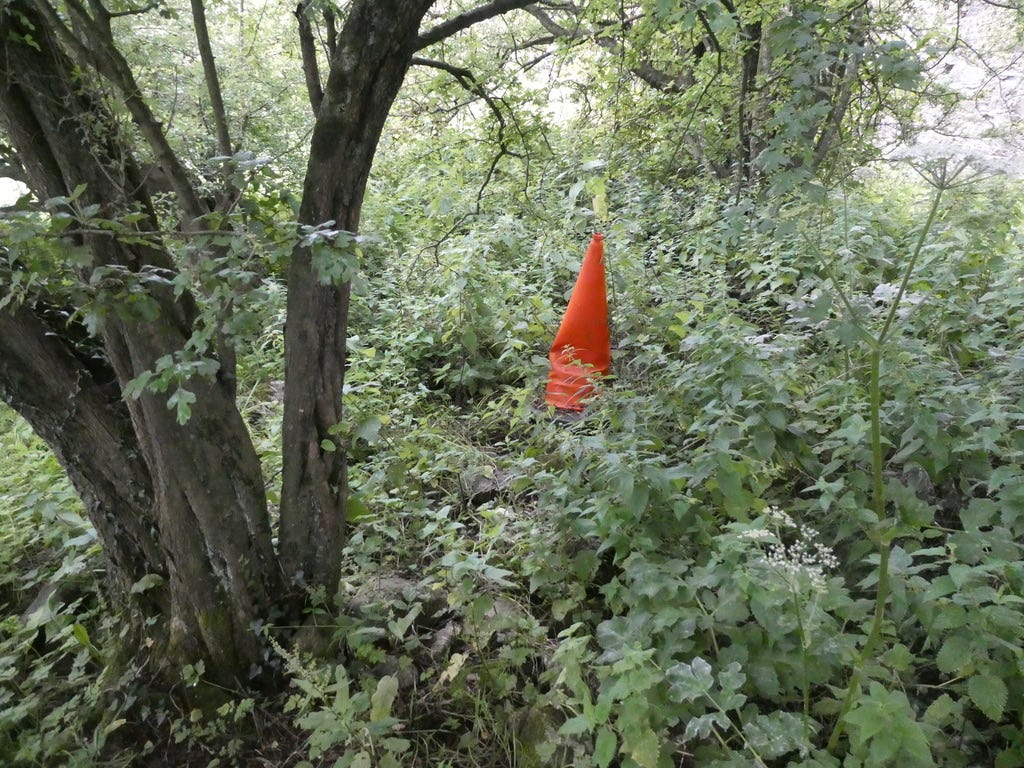St Anne’s Well, Ballylaneen, County Waterford
If I had a Euro for every hour I’ve spent scrubbing around remote bits of Ireland looking for wells that appear on the map but not on the ground, I would have … well, a few Euros. A Euro isn’t even a proper currency, and a few of them will barely buy you a bag of crisps these days, so it doesn’t matter in any case. The point is, some of these things are hard to find.
Ballylaneen in County Waterford is a tiny place with very little in it. A newish sort of church, some houses, some fields, lots of cows. On the map, I can see a graveyward marked, and sure enough, when we reach the little settlement, there it is, prominent on a rise, easy to find:
There is, according to the same map, a holy well in the field opposite. I am hoping for a signpost, a path, or at least a gate. My daughter and I wander up and down the road. Nothing. Not even a sign of any wellhouse in a field. There is nothing for it. We get over the fence somehow and start wandering about in the fields, looking at the map as we do so. Luckily there are no bulls on the prowl.
But there is no well either. The closest thing I can see, apparently near to where the little red dot appears on the Ordnance Survey map, is a small clump of trees. Coming closer, we see that they are thorn trees: traditionally used as rag trees over a well. Perhaps this is it? But the trees are wild and the ground in between them is clotted with nettles and sedge. We can see nothing.
Undaunted, as all true adventurers should be, we force ourselves into the nettly chaos. I’m looking for a dip in the ground, an old wellhouse, a stream, a big rock: anything that might show us where this thing is or might be. Nothing. Nothing, that is, except a broken orange traffic cone in the centre of the nettles. Lifting it up, I see that underneath it is a black plastic pipe, of the kind often used to pump water out of springs and into cattle troughs.
Is this it? Is this what I came for?
Basically, there is nothing here. But it is marked on the map. So, what has happened? I begin to wonder if somebody, at some time in the past, has done the one thing that nobody must ever do to a holy well if they want to live a happy life: fill it in.
Folklore is full of stories of what happens to those who mess with the wells. The villain in many of them is often an unnamed ‘protestant minister’ who blithely fills in a well, preaching all the time against ‘superstition’, only to have it bubble up inside his house, or bring him some other form of bad luck. I recounted one such story in my introduction to this series, in which the putative priest is outraged when locals refuse to draw water for him from the holy well to make his tea:
In a rage he snatched a can and brought a supply of water which he placed in a pot and hung over the fire to boil. Although under the influence of much heat the water remained quite cold while the minister waited his long overdue meal. Finally, his patience being exhausted he poured the water into another vessel and declared he would wash his feet in it. Witness his consternation and suffering when he touched the water his feet were immediately scalded and blistered as from a boiling heat.1
There are plenty of stories about non-protestant foolishness being punished too, often by the well moving of its own accord, in protest at some ill treatment. At one well in County Louth, for instance, a bunch of butchers polluted the well by washing the viscera of cattle in it, whereupon the well instantly dried up, later reappearing nearby, accompanied by a number of ghostly candles illuminating its new location for the locals.2
A little bit of digging - excuse the pun - suggests that something like this did indeed happen here. Schoolboy Thomas O’Flynn, writing nearly a century ago, tells the obviously-already-legendary story of a local farmer, one Joe Power, who, fed up with pilgrims wandering across his field to the well, had it filled in and dug an alternative one next to the road instead. ‘This tampering with the well was considered most unlucky for Power,’ writes the lad. ‘Things went from bad to worse until in the end he lost his farm and there is not a trace of his family in the district.’
The well that Joe Power filled in was patronised by St Anne, the mother of the Virgin Mary, to whom the local church is still dedicated. Whether she had anything to do with Joe’s fate, or whether the well itself was able to enact some form of revenge, we never learn. What we do learn is never to mess with a holy well, here or anywhere. The consequences are not worth risking.
Quoted in Amanda Clarke, Holy Wells of County Cork, 2023
These tales appear in ‘The Holy Wells of Ireland’, by Patrick Logan







To me the only reason to suppress a well spring is to destroy (or attempt to destroy) life creation of pure spring water of life. An act of Evil if ever I beheld one.
Power always wants to move things by force and seldom that is a holy act. Good story, thanks!